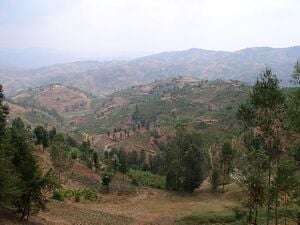
 Mountain gorillas: The ripple effect of conservation, BBC News (Jun 20, 2022)
Mountain gorillas: The ripple effect of conservation, BBC News (Jun 20, 2022)
Rwanda, officially the Republic of Rwanda, is a landlocked country in the Great Rift Valley of Central Africa, where the African Great Lakes region and Southeast Africa converge. Located a few degrees south of the Equator, Rwanda is bordered by Uganda, Tanzania, Burundi, and the Democratic Republic of the Congo. It is highly elevated, giving it the soubriquet "land of a thousand hills" (French: pays des mille collines), with its geography dominated by mountains in the west and savanna to the southeast, with numerous lakes throughout the country. The climate is temperate to subtropical, with two rainy seasons and two dry seasons each year. It is the most densely populated mainland African country; among countries larger than 10,000 km2, it is the fifth most densely populated country in the world. Its capital and largest city is Kigali.
Hunter-gatherers settled the territory in the Stone and Iron Ages, followed later by Bantu peoples. The population coalesced first into clans, and then into kingdoms. In the 15th century, one kingdom, under King Gihanga, managed to incorporate several of its close neighbor territories establishing the Kingdom of Rwanda. The Kingdom of Rwanda dominated from the mid-eighteenth century, with the Tutsi kings conquering others militarily, centralising power, and enacting unifying policies. In 1897, Germany colonized Rwanda as part of German East Africa, followed by Belgium, which took control in 1916 during World War I. Both European nations ruled through the Rwandan king and perpetuated a pro-Tutsi policy. The Hutu population revolted in 1959. They massacred numerous Tutsi and ultimately established an independent, Hutu-dominated republic in 1962 led by President Grégoire Kayibanda. A 1973 military coup overthrew Kayibanda and brought Juvénal Habyarimana to power, who retained the pro-Hutu policy. The Tutsi-led Rwandan Patriotic Front (RPF) launched a civil war in 1990. Habyarimana was assassinated in April 1994. Social tensions erupted in the Rwandan genocide that spanned one hundred days. The RPF ended the genocide with a military victory in July 1994.
Biodiversity
The wildlife of Rwanda comprising its flora and fauna, in prehistoric times, consisted of montane forest in one third the territory of present-day Rwanda. However, natural vegetation is now mostly restricted to the three national parks and four small forest reserves, with terraced agriculture dominating the rest of the country.
The national parks and forest reserves are under threat due to poaching, invasive plants such as water hyacinth, unauthorized livestock grazing, illegal fishing, bush fires, mining, bamboo harvesting, encroachment of protected land for agricultural farming, firewood gathering, be keeping and herbal plant extraction. This situation is attributed to governance issues lacking in legal acts and guidelines and also heavy anthropogenic pressure.
Conservation management plans have been instituted for all protected areas which involves the community of villages in and around the protected areas. Conservation activities have focused on increasing forest density by planting trees in a "natural self rehabilitation and natural regeneration of primary and high value species". The planting has involved Carissa macrocarpa, Entandrophragma (a genus of eleven species of deciduous trees) and Symphonia globulifera, and erecting protective fencing around forest reserves using leguminous thorny plants.
One of the efforts initiated by the government of Rwanda was to increase the number of protected areas and to proliferate tree plantations to increase the forest area cover of 10% to 20% by 2020.
Trees, woodland and forest
The country had a 2019 Forest Landscape Integrity Index mean score of 3.85/10, ranking it 139th globally out of 172 countries. — From Wikipedia:Rwanda#Biodiversity
Ecoregions
Rwanda contains three terrestrial ecoregions: Albertine Rift montane forests, Victoria Basin forest-savanna mosaic, and Ruwenzori-Virunga montane moorlands. — From Wikipedia:Rwanda#Biodiversity
Community energy
The use of off-grid solar power has increased as solar panel prices have fallen and many areas do not expect grid connections in the near future. Solar power produces over 2% of electricity in the country. The country is in the midst of a rapid expansion of its electrical grid and many new plants are proposed or under construction.
News and comment
2021
Rugby bringing African communities together, Feb 4[1]
2017
Rural Rwanda is home to a pioneering new solar power idea, Oct 9[2]
2015
Road safety initiative helps Rwanda's motorbike taxis stay on the right track, Clar Ni Chonghaile, December 28[3]
How Africa's fastest solar power project is lighting up Rwanda, November 23[4]
How Rwanda's clinics have gone off-grid and onto renewable energy, June 25[5]
2010
2010 SEED Award Winners,[6] November 3
"Production and Distribution of Pressurized Biogas in Gas Cylinders". This initiative has been developed by a private company, an international NGO and government organizations to produce and store pressurised biogas for cooking made from urban, domestic and industrial wastes. Environmental benefits are achieved by offering an alternative firing material to firewood and charcoal.
"Efficient Charcoal Production and Smoke Recycling". This partnership of international NGOs, government institutions and a reforestation initiative is promoting new technologies to increase the energy output of charcoal. As a result, this significantly reduces the amount of forestland used for the production of charcoal and lessens air pollution by recycling tar and other smoke components.
Rwanda named global host of World Environment Day 2010,[7] February 17